Simple android page | Android App Development
We shall try to build an android page for a famous monument- Taj Mahal to learn about views and view groups. Hope you know the basics of designing android apps.
Already excited?🤩
Lets look at what we are going to build-
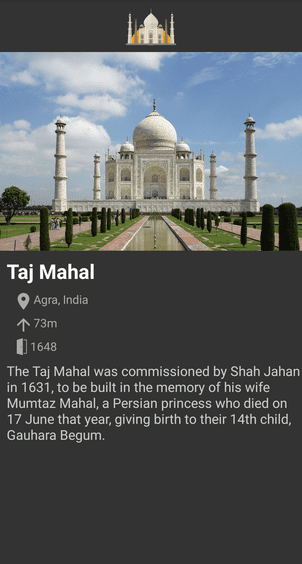 Pretty cool, right?
Pretty cool, right?
First things first
Undo any changes you have done to your new app or create a new app and remove the TextView displaying Hello world. Then, switch to dark theme. Yay!🌃
Making things dark
In the Project window, select Android view (refer to this post) and locate the file colors.xml (app > res > values > colors.xml) and update the file as such-
<?xml version="1.0" encoding="utf-8"?>
<resources>
<color name="colorPrimary">@android:color/black</color> <color name="colorPrimaryDark">@android:color/black</color> <color name="colorAccent">@android:color/darker_gray</color></resources>So, what exactly happened? We just defined some colors which will be used in our app. So, colorPrimary would return @android:color/black that you can guess is black and so on.
So, colors.xml is used to pre define some colors that can be used in our app.
Now, locate the styles.xml in the same directory and update as such-
<resources>
<!-- Base application theme. -->
<style name="AppTheme" parent="Theme.AppCompat.Light.NoActionBar"> <!-- Customize your theme here. -->
<item name="colorPrimary">@color/colorPrimary</item> <item name="colorPrimaryDark">@color/colorPrimaryDark</item> <item name="colorAccent">@color/colorAccent</item> </style>
</resources>This is were we are informing android about the theme and styles used in our app. Here, we are specifying that our app should not have action bar/ toolbar and the various types of color for app theme. The following picture will help you to understand what different style item means to android.
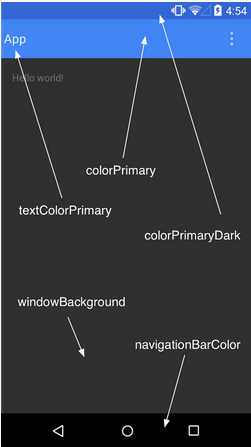 So for our app, we set the status bar and action bar's color to black and accent color (such as for checkboxs, radio buttons etc.) to be grey. These colors are fetched from the
So for our app, we set the status bar and action bar's color to black and accent color (such as for checkboxs, radio buttons etc.) to be grey. These colors are fetched from the colors.xml file!
Time to add some images and text
Locate activity_main.xml (app > res > layout > activity_main.xml) and you will find it starting with a tag named ConstraintLayout.
Constraint Layout
ConstraintLayout is a view group which allows us to create large, complex and flexible layouts without much nesting (of view groups). We use constraints to specify how views are relatively positioned with their parent or each other. We will use it to build our layout and see how awesome this is! Constraint layout can be used by just drag-and-drop feature but we will stick to writing xml code for now.
You can check this codelab by Google on ConstraintLayout for a complete overview.
Now, we change the background color of our layout-
<androidx.constraintlayout.widget.ConstraintLayout
xmlns:android="http://schemas.android.com/apk/res/android"
xmlns:tools="http://schemas.android.com/tools"
android:layout_width="match_parent"
android:layout_height="match_parent"
android:background="#333" tools:context=".MainActivity">
</androidx.constraintlayout.widget.ConstraintLayout>Changing the backgroud color to #333 gives us this result-
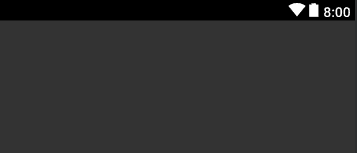 Dark!❤
Dark!❤
Image time!⏰
There goes our first image-
<ImageView
android:id="@+id/iv_tm_top"
android:layout_width="match_parent"
android:layout_height="60dp"
android:contentDescription="Taj Mahal"
android:src="@drawable/tajmahal"
app:layout_constraintTop_toTopOf="parent" />Lets understand one line at a time-
ImageViewis the view responsible for displaying images in our app.idattribute identifies the view uniquely in the layout and then the view can be later refered using it. The general syntax for creating an id is-@+id/id_namelayout_widthandlayout_heightspecifies the how much space should the view occupy horizontally and vertically respectively. Width is set tomatch_parentmeaning take up all the remaining horizontal space available to the view. Height is set to60dpmeaning occupy 60 density independent pixels vertically.contentDescription, as the name suggests, is used to provide a short description for image.srcis used to specify the path of the image asset to display. All the image assets are kept insidedrawablefolder (app > res > drawable). Go ahead and download one for you. In this case, I have an image named tajmahal. A general syntax would be-@drawable/image_file_name(Note: no extension)layout_constraintTop_toTopOf: This specifies a constraint for the image such that the top of the image is to the top ofparent(in this case) or may be any other view. So, it sticks to the top of the screen. Pretty intuitive, right?
Lets add the bigger image really fast.
<ImageView
android:id="@+id/iv_tm_main"
android:layout_width="match_parent"
android:layout_height="wrap_content"
android:adjustViewBounds="true"
android:contentDescription="Taj Mahal"
android:src="@drawable/tajmahalbig"
app:layout_constraintTop_toBottomOf="@id/iv_tm_top" />- Notice
wrap_contentfor height. It says take up only that space which I actually need. So if an image's height is 40px, it will take just 40px. adjustViewBoundsis a simple way to preserve image's aspect ratio. Try experimenting with it!layout_constraintTop_toBottomOfspecifies that the top of the image should be at the bottom of our smaller image. Notice how the above image is referenced. Note: No+symbol. This is actually intuitive,+while creating the id and nothing while referencing!
This is the current output-
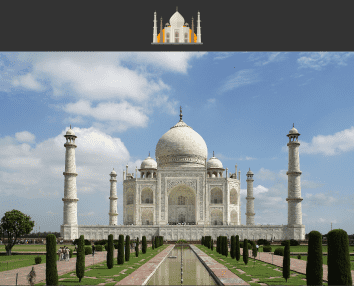 It took architectural geniuses 17 years to complete the Taj Mahal but just 17mins for you!😜
It took architectural geniuses 17 years to complete the Taj Mahal but just 17mins for you!😜
Lots of images!😫 Lets add some text so that it makes sense
Every app contains some text, doesn't it?
Let our first text roll in🥁
<TextView
android:id="@+id/tv_tajmahal"
android:layout_width="wrap_content"
android:layout_height="wrap_content"
android:layout_margin="8dp"
android:text="Taj Mahal"
android:textColor="@android:color/white"
android:textSize="24sp"
android:textStyle="bold"
app:layout_constraintStart_toStartOf="parent"
app:layout_constraintTop_toBottomOf="@id/iv_tm_main" />I hope this is clean and intuitive. The margin attribute pushes the view <value> distance away from all the sides and the extra space is not the part of the view. The result should be something like this-

Adding the details
We will use the LinearLayout to add some details about our monument. Lets see how does is look-
<LinearLayout
android:id="@+id/ll_info"
android:layout_width="match_parent"
android:layout_height="wrap_content"
android:layout_margin="8dp"
android:orientation="vertical"
android:paddingStart="8dp"
android:paddingEnd="8dp"
app:layout_constraintStart_toStartOf="parent"
app:layout_constraintTop_toBottomOf="@id/tv_tajmahal">
<TextView
android:layout_width="wrap_content"
android:layout_height="wrap_content"
android:drawableStart="@drawable/location"
android:text="Agra, India"
android:textColor="@android:color/darker_gray"
android:textSize="14sp" />
<TextView
android:layout_width="wrap_content"
android:layout_height="wrap_content"
android:layout_marginTop="4dp"
android:drawableStart="@drawable/height"
android:text="73m"
android:textColor="@android:color/darker_gray"
android:textSize="14sp" />
<TextView
android:layout_width="wrap_content"
android:layout_height="wrap_content"
android:layout_marginTop="4dp"
android:drawableStart="@drawable/opengate"
android:text="1648"
android:textColor="@android:color/darker_gray"
android:textSize="14sp" />
</LinearLayout>DO NOT PANIC! Its really simple.
The linear layout allows us to align the views in a single direction (vertical or horizontal specified by orientation attribute). So all the TextViews in the above LinearLayout are stacked vertically. Check this page from android developers website for an overview of LinearLayout. Though we always use contraint layout for various reasons including performance, we used linear layout here for the sake of demonstration.
paddingis very similar tomargin. One of the main difference is that the view owns the padded space while margin is outside the view. Please refer to this StackOverflow answer for a better understanding of their difference.drawableStartattribute in the text view is used to add an image before the actual text. This image is part of theTextView.
This is how it looks like-
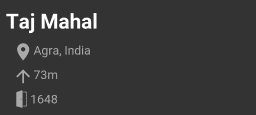
Wrapping up
Finally add a paragraph about Taj Mahal-
<TextView
android:layout_width="wrap_content"
android:layout_height="wrap_content"
android:layout_margin="8dp"
android:layout_marginTop="4dp"
android:text="The Taj Mahal was commissioned by Shah Jahan in 1631, to be built in the memory of his wife Mumtaz Mahal, a Persian princess who died on 17 June that year, giving birth to their 14th child, Gauhara Begum."
android:textColor="#ccc"
android:textSize="16sp"
app:layout_constraintStart_toStartOf="parent"
app:layout_constraintTop_toBottomOf="@id/ll_info" />Final code
This is the final code for activity_main.xml-
<?xml version="1.0" encoding="utf-8"?>
<androidx.constraintlayout.widget.ConstraintLayout
xmlns:android="http://schemas.android.com/apk/res/android"
xmlns:app="http://schemas.android.com/apk/res-auto"
xmlns:tools="http://schemas.android.com/tools"
android:layout_width="match_parent"
android:layout_height="match_parent"
android:background="#333"
tools:context=".MainActivity">
<ImageView
android:id="@+id/iv_tm_top"
android:layout_width="match_parent"
android:layout_height="60dp"
android:contentDescription="Taj Mahal"
android:src="@drawable/tajmahal"
app:layout_constraintTop_toTopOf="parent" />
<ImageView
android:id="@+id/iv_tm_main"
android:layout_width="match_parent"
android:layout_height="wrap_content"
android:adjustViewBounds="true"
android:contentDescription="Taj Mahal"
android:src="@drawable/tajmahalbig"
app:layout_constraintTop_toBottomOf="@id/iv_tm_top" />
<TextView
android:id="@+id/tv_tajmahal"
android:layout_width="wrap_content"
android:layout_height="wrap_content"
android:layout_margin="8dp"
android:text="Taj Mahal"
android:textColor="@android:color/white"
android:textSize="24sp"
android:textStyle="bold"
app:layout_constraintStart_toStartOf="parent"
app:layout_constraintTop_toBottomOf="@id/iv_tm_main" />
<LinearLayout
android:id="@+id/ll_info"
android:layout_width="match_parent"
android:layout_height="wrap_content"
android:layout_margin="8dp"
android:orientation="vertical"
android:paddingStart="8dp"
android:paddingEnd="8dp"
app:layout_constraintStart_toStartOf="parent"
app:layout_constraintTop_toBottomOf="@id/tv_tajmahal">
<TextView
android:layout_width="wrap_content"
android:layout_height="wrap_content"
android:drawableStart="@drawable/location"
android:text="Agra, India"
android:textColor="@android:color/darker_gray"
android:textSize="14sp" />
<TextView
android:layout_width="wrap_content"
android:layout_height="wrap_content"
android:layout_marginTop="4dp"
android:drawableStart="@drawable/height"
android:text="73m"
android:textColor="@android:color/darker_gray"
android:textSize="14sp" />
<TextView
android:layout_width="wrap_content"
android:layout_height="wrap_content"
android:layout_marginTop="4dp"
android:drawableStart="@drawable/opengate"
android:text="1648"
android:textColor="@android:color/darker_gray"
android:textSize="14sp" />
</LinearLayout>
<TextView
android:layout_width="wrap_content"
android:layout_height="wrap_content"
android:layout_margin="8dp"
android:layout_marginTop="4dp"
android:text="The Taj Mahal was commissioned by Shah Jahan in 1631, to be built in the memory of his wife Mumtaz Mahal, a Persian princess who died on 17 June that year, giving birth to their 14th child, Gauhara Begum."
android:textColor="#ccc"
android:textSize="16sp"
app:layout_constraintStart_toStartOf="parent"
app:layout_constraintTop_toBottomOf="@id/ll_info" />
</androidx.constraintlayout.widget.ConstraintLayout>And this is the result-
 Beautiful! Isn't it?✨
Beautiful! Isn't it?✨
Wohoo! You have reached the end.🎉🎊
Go ahead and make your own page, may be about yourself, your pet or a restaurant. And don't forget to share your work in the comments below.